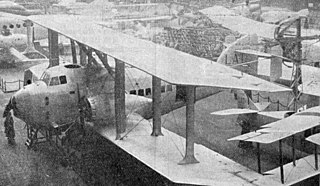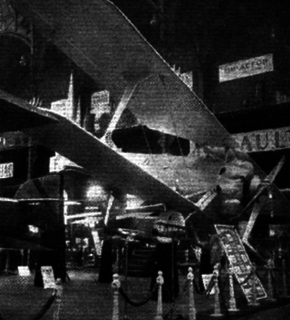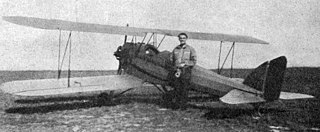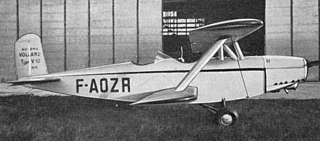Related Research Articles

The Latécoère 4 was a three-engined, 15-passenger biplane built in France in the early 1920s. It proved difficult to fly and was discontinued, though a second machine was completed as the Latécoère 5 bomber.

The Hanriot H.31 was a single engine, single seat French biplane fighter aircraft built in 1925 to compete in a government programme. It was not successful and only one prototype was completed.

The Caudron C.43 was the first French five-engined aircraft, a biplane intended for passenger transport or military use and multi-engined for safety. A development of the three-engined Caudron C.39, it had one tractor configuration engine in the nose and two push-pull pairs between the wings. It was capable of carrying eight passengers but was not developed.

The Caudron Type L was a two-seat French pusher configuration amphibious biplane, flown around 1913 and intended for naval use.

The Feiro Dongó was a Hungarian side-by-side trainer biplane. It was notable for its high aspect ratio wings, aerodynamic clearness and high lift/drag ratio.
The Caudron Type C was a single seat French biplane, intended for military evaluation. Two were built in 1911.

The Heinkel HD 20 was a twin engine, three seat German biplane built in 1926 for civil survey work.

The Latham HB.5 was a French biplane flying boat with four engines in push-pull configuration pairs. Ten were used by the French Navy.
The Latham Trimotor was a large French trimotor biplane built just after World War I and used in small numbers by the French Navy.
The Weymann W-100, Weymann CTW-100 or Weymann W-100 RBL was a French three seat observation aircraft with a position for the observer within its partially glazed fuselage. Only one was built.

The CAMS 110 was a French twin engine biplane flying boat built to fill a range of maritime military rôles including long range reconnaissance, bombing and general exploration. it was not selected for production and only one was built.

Bessard-Millevoye Moineau (Sparrow) was a single seat, low-powered French biplane intended to increase participation in popular aviation. Only one was built.

The Volland V-10 was a French two seat, low-powered biplane notable for its extreme stagger. It first flew in 1936 and appeared at the Paris Aero Salon that year.
The Latham L.1 was a French competitor in the 1923 Schneider Trophy race. It was a twin engine, biplane flying boat, built by Société Latham.
The Caproni Ca.61 was an Italian heavy day bomber aircraft of 1922. It was the final development of the Caproni three engine, twin boom biplane types developed during World War I, but it was not put into production.
The Peyret-le Prieur seaplane was a low power, two seat biplane floatplane trainer flown in France in 1924. It did not reach production.
The Potez 24 A.2 was a mid-1920s French biplane intended to replace the Potez 15 as an army observation aircraft. The further improved and larger Potez 25 was preferred for production.

The Lioré et Olivier Leo H-15 was a French twelve-seat civil flying boat, flown in a national contest in 1926. It did not win but set two load carrying records, one a world record.

The CAMS 54 was a strengthened and more powerful version of the French CAMS 51 civil transport and naval reconnaissance flying boat, developed for transatlantic flights. It is sometimes referred to as the 54 GR.
The Caudron C.92 was a passenger transport built by Caudron in 1925, powered by a 370 hp (280 kW) Lorraine-Dietrich 12D. Only one was built, and it was discarded in July 1934.
References
- ↑ "L'hydravion Tri-moteur Latham". L'Aéronautique. 2 (18): 220. November 1920.
- ↑ Lemonon, E.-H. (4 August 1921). "L'hydravion Latham". Les Ailes (7): 2–3.
- 1 2 3 4 5 6 7 Serryer, J. (27 August 1925). "L'hydravion Latham 1,600 CV". Les Ailes. 7 (219): 2–3.
- 1 2 "L'hydravion quadrimoteur Latham 1600 HP". L'Aéronautique. 7 (76): 357. September 1925.
- ↑ "L'hydravion quadrimoteur Latham 1600 HP". L'Aéronautique. 7 (76): 333. September 1925.